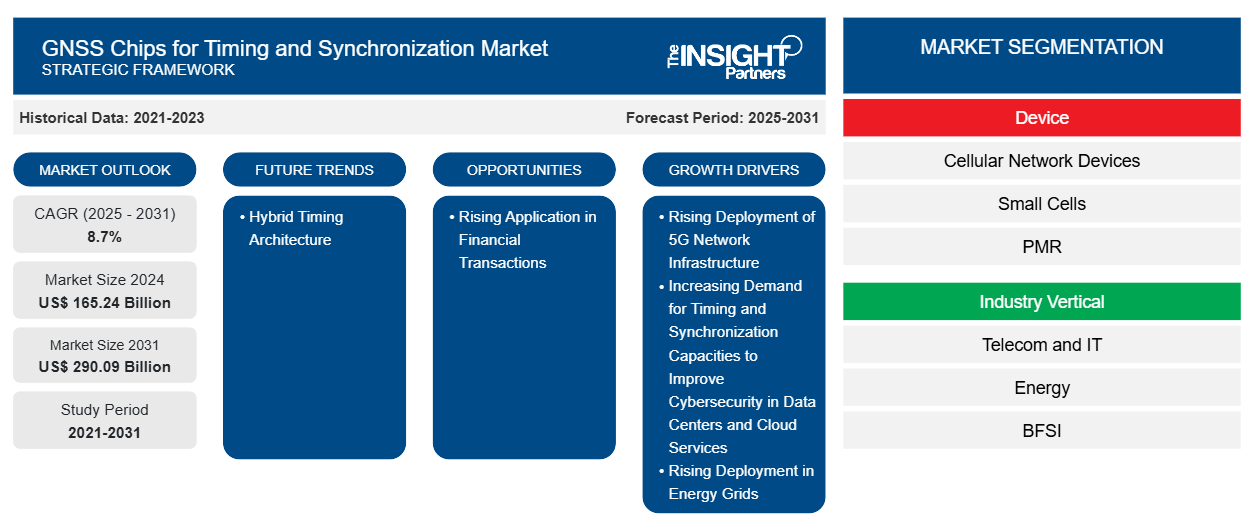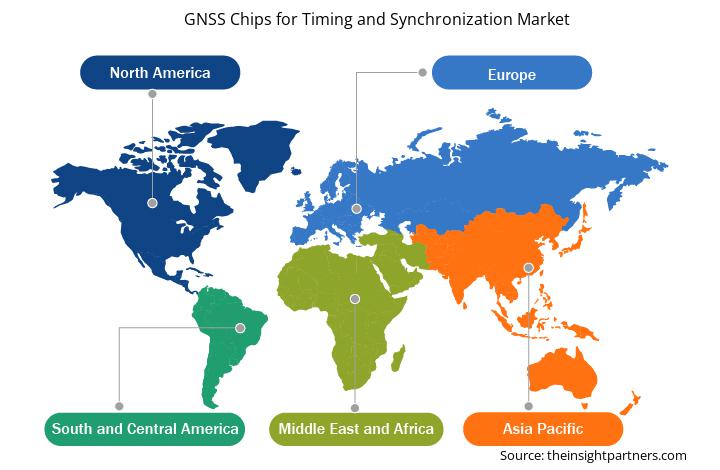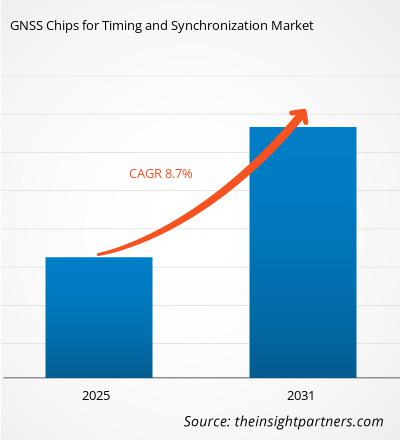预计到2031年,用于授时和同步的GNSS芯片市场规模将从2024年的1.6524亿美元增至2.9009亿美元。预计2025年至2031年期间,该市场的复合年增长率将达到8.7%。混合授时架构很可能在未来几年为市场带来新的趋势。
用于授时和同步的 GNSS 芯片市场分析
数据中心、电网、金融网络和电信对精确计时的需求日益增长,这推动了用于计时和同步的 GNSS 芯片市场的发展。随着 5G 网络的引入,这种需求更加强烈,因为这些网络的可靠性和超低延迟依赖于毫秒级的同步。GNSS 与边缘计算和物联网的融合正在创造巨大的机遇,因为精确的计时对于实时数据传输是必不可少的。多频 GNSS 技术和抗干扰能力的发展进一步支持了 GNSS 芯片在关键基础设施中的使用。行业标准和政府法规也促使人们投资于可靠和可验证的计时源。此外,全球数字化转型的加速,特别是在智慧城市和自治系统领域,使得基于 GNSS 的计时解决方案可以在商业和工业环境中得到更广泛的应用。
GNSS 授时和同步芯片市场概况
全球导航卫星系统 (GNSS) 是一个卫星网络,它将定位和授时数据传输到接收器,接收器将这些数据与传感器输入相结合,以确定位置、速度和高度。GNSS 芯片的精度取决于可见卫星的数量和信号质量。因此,一些政府正试图部署区域性卫星星座,以改进导航和测绘。中国、俄罗斯、美国、印度、日本和欧盟都已开发并投入运营各自的 GNSS,在全球市场上提供具有竞争力的替代方案。由于关键基础设施对精确计时的需求日益增长,用于授时和同步的 GNSS 芯片的需求正在稳步增长。电信等关键行业,尤其是随着 5G 网络的推出,需要高精度授时性能,以确保基站同步并确保低延迟通信。同样,电网使用基于 GNSS 的授时,通过 Phazor 测量单元 (PMU) 来确保电网稳定性和故障检测。金融行业也需要纳秒级同步,以实现高频交易和合规性。
您可以免费定制任何报告,包括本报告的部分内容、国家级分析、Excel 数据包,以及为初创企业和大学提供优惠和折扣
用于授时和同步的 GNSS 芯片市场:战略洞察

- 获取此报告的顶级关键市场趋势。此免费样品将包括数据分析,从市场趋势到估计和预测。
用于授时和同步的 GNSS 芯片市场驱动因素和机遇
能源网部署不断增加
在能源行业,时间同步的重要性日益凸显,因为它能够确保不同电网组件之间的精确协调。电网的可靠性高度依赖于这种同步,这使得故障管理、事件跟踪和有效通信成为可能。随着电网融合先进技术(例如智能电网)和可再生能源,保持精确的时间同步对于最大限度地提高性能和维护电网稳定性至关重要。
Phazor 测量单元 (PMU) 用于网络自动保护系统(广域测量系统/广域控制系统),作为自动保护(供未来使用)和网络监控(供当前使用)的计时和同步数据源。在 PMU 层面,自动保护需要高度的精度和冗余度。PMU 被放置在远程电力网络节点,并使用 GNSS 接收器作为内部时间参考。能源项目开发商、公用事业公司、能源资产生产商、融资方、政府机构、能源经销商和供应链管理者被视为能源领域的主要利益相关者。这些利益相关者利用空间数据来审核环境法规和政策、开发和监控资产,并通过获取通用知识来获得优势。
金融交易中日益增多的应用
金融服务需要强大的IT网络和系统,这些网络和系统需要高度的可用性、安全性和可靠性。为了实现同步和时间戳,GNSS用于按时间顺序记录报价或事件。在金融交易中使用GNSS的各种优势如下:
- 增强的安全性:基于 GNSS 的时间戳使交易无法被渗透,并且还能维护交易的精确记录。
- 更高的可靠性:GNSS 提供可靠的计时源,降低出现错误或分歧的可能性。
- 合规性:金融机构可以使用基于 GNSS 的时间戳来遵守监管义务。
计时和同步解决方案对于金融交易的时间戳至关重要。监管机构要求每笔交易都具有极其精确的时间戳,以确保交易安全、消除欺诈并防止消费者数据被篡改。仅在美国,每年发生的金融交易就造成数万亿美元的巨额损失。金融行业的大多数计时系统仍然基于网络时间协议 (NTP) 方法。时间同步通过局域网连接在交易所、数据中心和成员单位内部执行。参考时钟通常来自 GNSS 信号和铷原子钟。因此,GNSS 芯片在金融交易中的应用日益增多,预计将为 GNSS 计时和同步芯片市场的增长带来重大机遇。
用于授时和同步的 GNSS 芯片市场报告细分分析
有助于推导用于计时和同步的 GNSS 芯片市场分析的关键部分是设备和行业垂直领域。
- 按设备类型划分,GNSS授时和同步芯片市场可细分为蜂窝网络设备、小型基站、PMR(公共移动无线电)、Phazor测量单元(PMU)和其他。2024年,其他细分市场占据了GNSS授时和同步芯片市场的最大份额。
- 全球GNSS授时和同步芯片市场按垂直行业细分为电信和IT、能源、金融、保险和保险业(BFSI)、消费电子、汽车和运输等。2024年,电信和IT领域占据GNSS授时和同步芯片市场的最大份额。
GNSS 授时和同步芯片市场份额(按地区)分析
用于计时和同步的 GNSS 芯片市场报告的地理范围主要分为五个区域:北美、亚太地区、欧洲、中东和非洲以及南美和中美。
2024 年,北美占据了相当大的市场份额。北美用于授时和同步的 GNSS 芯片市场细分为美国、加拿大和墨西哥。随着电力系统不断发展以适应日益增长的需求和对可再生能源的更大依赖,用于授时和同步的 GNSS 芯片市场正在经历强劲增长,这得益于对现代化电网基础设施进行精确、实时协调的迫切需求。该地区的国家正致力于电网现代化。例如,2024 年 5 月,拜登-哈里斯政府启动了“联邦-州现代电网部署计划”,以加速改善输配电网络,这对于实现该国负担得起、清洁、可靠和有韧性的电力目标至关重要。由于电网利益相关者面临着互连延迟、线路拥堵以及极端天气带来的可靠性风险增加等挑战,由 GNSS 技术实现的高精度时间同步对于管理分布式能源、提高电网稳定性以及确保清洁能源解决方案的无缝集成至关重要。在更加智能、更具弹性的电网中,GNSS 芯片的重要性也日益增加,这推动了该地区 GNSS 时间和同步芯片市场的发展。
用于授时和同步的 GNSS 芯片市场区域洞察
Insight Partners 的分析师已详尽阐述了预测期内影响 GNSS 授时和同步芯片市场的区域趋势和因素。本节还讨论了北美、欧洲、亚太地区、中东和非洲以及南美和中美洲的 GNSS 授时和同步芯片市场细分和地域分布。

- 获取用于授时和同步市场的 GNSS 芯片的区域特定数据
用于授时和同步的 GNSS 芯片市场报告范围
| 报告属性 | 细节 |
|---|---|
| 2024年的市场规模 | 1652.4亿美元 |
| 2031年的市场规模 | 2900.9亿美元 |
| 全球复合年增长率(2025-2031) | 8.7% |
| 史料 | 2021-2023 |
| 预测期 | 2025-2031 |
| 涵盖的领域 | 按设备
|
| 覆盖地区和国家 | 北美
|
| 市场领导者和主要公司简介 |
|
用于授时和同步的 GNSS 芯片市场参与者密度:了解其对业务动态的影响
GNSS授时和同步芯片市场正在快速增长,这得益于终端用户需求的不断增长,而这些需求的驱动因素包括消费者偏好的演变、技术进步以及对产品优势的认知度的提升。随着需求的增长,企业正在扩展产品线,不断创新以满足消费者需求,并抓住新兴趋势,从而进一步推动市场增长。
市场参与者密度是指特定市场或行业内企业或公司的分布情况。它表明特定市场空间内竞争对手(市场参与者)的数量相对于其规模或总市值而言。
在 GNSS 授时和同步芯片市场运营的主要公司有:
- 博通公司
- Septentrio NV
- 古野电气株式会社
- 移远通信股份有限公司
- u-blox 控股公司
- Protempis有限责任公司
免责声明:以上列出的公司没有按照任何特定顺序排列。

- 获取用于授时和同步的 GNSS 芯片市场主要参与者概览
用于授时和同步的 GNSS 芯片市场新闻和最新发展
GNSS授时和同步芯片市场评估是通过收集一手和二手研究的定性和定量数据进行的,这些数据包括重要的企业出版物、协会数据和数据库。以下列出了GNSS授时和同步芯片市场的一些发展情况:
- Protempis(前身为 Trimble 的时间和频率部门)宣布,将为 OCP-TAP 的开源计时卡参考设计提供其业界领先的双频段授时接收器 Res720 嵌入式模块。Res720 GNSS 嵌入式授时模块是数据中心、5G Open RAN/XHaul、智能电网、工业自动化和卫星通信网络的理想解决方案。它提供无与伦比的性能,授时精度高达 5 纳秒,并支持双频段 GNSS 和抗干扰/防欺骗功能。(来源:Protempis,新闻稿,2022 年 6 月)
- LOCOSYS Technology宣布推出三款新型高性能GNSS/RTK卫星定位模块:SO-1612-15、SO-1612-1N和SOR-1612。这些模块采用索尼最新的CXD 5610GF芯片,提供卓越的定位精度和稳定性,并支持多种全球卫星系统,包括GPS(美国)、GLONASS(俄罗斯)、Galileo(欧洲)和北斗(中国)。它们专为支持最新的QZSS信号(L1 C/B)而设计,可提高日本及亚太地区的定位精度和可靠性。(来源:LOCOSYS Technology,新闻稿,2024年8月)
用于授时和同步的 GNSS 芯片市场报告覆盖范围和交付成果
《GNSS 授时和同步芯片市场规模及预测(2021-2031)》报告对以下领域进行了详细的市场分析:
- 用于计时和同步的 GNSS 芯片市场规模以及该范围涵盖的所有关键细分市场的全球、区域和国家层面的预测
- 用于授时和同步的 GNSS 芯片市场趋势,以及驱动因素、限制因素和关键机遇等市场动态
- 详细的 PEST 和 SWOT 分析
- 用于计时和同步的 GNSS 芯片市场分析,涵盖关键市场趋势、全球和区域框架、主要参与者、法规和最新市场发展
- 行业格局和竞争分析,涵盖市场集中度、热图分析、知名参与者以及 GNSS 计时和同步芯片市场的最新发展
- 详细的公司简介
- 历史分析(2 年)、基准年、预测(7 年)及复合年增长率
- PEST和SWOT分析
- 市场规模、价值/数量 - 全球、区域、国家
- 行业和竞争格局
- Excel 数据集
近期报告
客户评价
购买理由
- 明智的决策
- 了解市场动态
- 竞争分析
- 客户洞察
- 市场预测
- 风险规避
- 战略规划
- 投资论证
- 识别新兴市场
- 优化营销策略
- 提升运营效率
- 顺应监管趋势




















 获取免费样品 - 用于授时和同步市场的 GNSS 芯片
获取免费样品 - 用于授时和同步市场的 GNSS 芯片